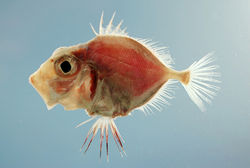| Parazenidae | |
|---|---|
 | |
| Rosy dory (Cyttopsis rosea) | |
| Scientific classification | |
| Domain: | Eukaryota |
| Kingdom: | Animalia |
| Phylum: | Chordata |
| Class: | Actinopterygii |
| Order: | Zeiformes |
| Family: | Parazenidae Greenwood, Rosen, S. H. Weitzman & G. S. Myers, 1966 |
| Subfamilies and genera [1] | |
Subfamily Cyttopsinae | |
Parazenidae is a family of zeiform fishes found in the Atlantic and Pacific Oceans.